 olleyball
is a team sport.
olleyball
is a team sport.
 Each person on the team plays a role, and the overall success of the team
depends on how well the individual people function together as a team.
Several of the people gathered to play volleyball were also musicians, and
they got together to provide an impromptu concert. In order for the music to
sound good to the listeners, the musicians also had to work together as a
team. Similarly, our body is comprised of several system. Each system is
made up of several organs. Each organ includes several types of tissues.
Each tissue is composed of cells, and in each cell are organelles, each with their
own shapes and functions. A person’s body is definitely a “team effort.”
Each person on the team plays a role, and the overall success of the team
depends on how well the individual people function together as a team.
Several of the people gathered to play volleyball were also musicians, and
they got together to provide an impromptu concert. In order for the music to
sound good to the listeners, the musicians also had to work together as a
team. Similarly, our body is comprised of several system. Each system is
made up of several organs. Each organ includes several types of tissues.
Each tissue is composed of cells, and in each cell are organelles, each with their
own shapes and functions. A person’s body is definitely a “team effort.”
Introduction to Body Systems and Organs
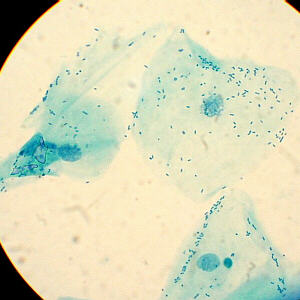 The bodies of all living organisms
are made up of cells – cells are the basic “building blocks” of life.
Non-living objects such as rocks do not contain cells. Cells, however, are
made of even smaller pieces! Electrons, protons, and neutrons are
about the smallest particles of which we humans are aware.
Those join together in specific ratios to form elements such as oxygen or
sodium. Elements join together to form chemical compounds
such as water or one of the many proteins. Within our cells, chemical
compounds join together in specific ways to form organelles, which are like
“body parts” within cells. Each type of organelle has a specific chemical
composition and function. Dr. Fankhauser’s photograph shows three cells
(stained light blue) from the inside of someone’s cheek. In the center of
each cell is a more darkly stained nucleus. The nucleus of a cell contains
the cell’s DNA, the instructions for making all the proteins that cell
needs.
The bodies of all living organisms
are made up of cells – cells are the basic “building blocks” of life.
Non-living objects such as rocks do not contain cells. Cells, however, are
made of even smaller pieces! Electrons, protons, and neutrons are
about the smallest particles of which we humans are aware.
Those join together in specific ratios to form elements such as oxygen or
sodium. Elements join together to form chemical compounds
such as water or one of the many proteins. Within our cells, chemical
compounds join together in specific ways to form organelles, which are like
“body parts” within cells. Each type of organelle has a specific chemical
composition and function. Dr. Fankhauser’s photograph shows three cells
(stained light blue) from the inside of someone’s cheek. In the center of
each cell is a more darkly stained nucleus. The nucleus of a cell contains
the cell’s DNA, the instructions for making all the proteins that cell
needs.
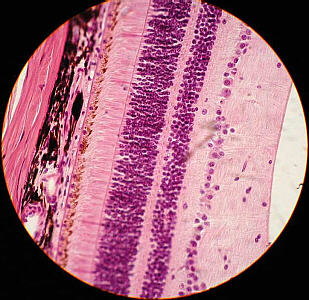 The cells in our bodies are organized into tissues,
groups of cells with a common structure and function. We recognize four main
categories of tissue in our bodies: epithelial tissue, connective tissue,
nervous tissue,
and muscle tissue. Dr. Fankhauser’s photograph of a side-view of the retina
of an eye shows about six or seven layers of tissue of which that retina is
composed.
The cells in our bodies are organized into tissues,
groups of cells with a common structure and function. We recognize four main
categories of tissue in our bodies: epithelial tissue, connective tissue,
nervous tissue,
and muscle tissue. Dr. Fankhauser’s photograph of a side-view of the retina
of an eye shows about six or seven layers of tissue of which that retina is
composed.
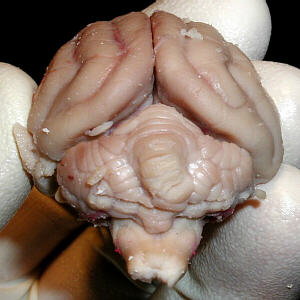 Layers of tissues are combined in various ways to make body organs, such as
this brain (Dr. Fankhauser’s photo is of a cat brain, but ours
looks similar). In our stomach, for example, there is a layer of epithelial
tissue on the outside, then several layers of muscle tissue, then on the
inside, a layer of
mucus membrane tissue with secretory cells interspersed.
Layers of tissues are combined in various ways to make body organs, such as
this brain (Dr. Fankhauser’s photo is of a cat brain, but ours
looks similar). In our stomach, for example, there is a layer of epithelial
tissue on the outside, then several layers of muscle tissue, then on the
inside, a layer of
mucus membrane tissue with secretory cells interspersed.
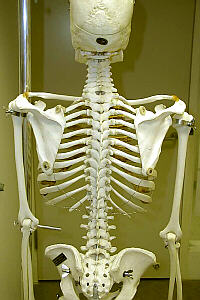 Our various body organs are joined together into body systems, each of which
has a specific function. For example our mouth, esophagus,
stomach, small intestine, and large intestine are all parts of our digestive
system. Dr. Fankhauser’s photo shows many of the bones which comprise the
skeletal system, which functions to provide support and protection for the
other body organs.
Our various body organs are joined together into body systems, each of which
has a specific function. For example our mouth, esophagus,
stomach, small intestine, and large intestine are all parts of our digestive
system. Dr. Fankhauser’s photo shows many of the bones which comprise the
skeletal system, which functions to provide support and protection for the
other body organs.
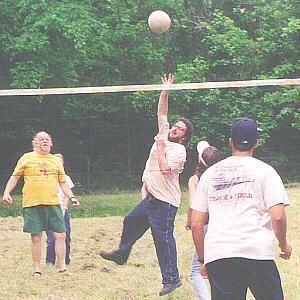 All of these body systems work together to make up our whole body. Each
system has its own function, and all must work together to
maintain proper functioning of the body as a whole. For example, either if
the endocrine cells in the pancreas produce too much or not enough insulin,
or if the insulin receptor cells in the liver are unable to properly receive
and respond to insulin, in either case that can “mess up” the blood-sugar
level, making it too high (diabetes) or too low (hypoglycemia). Because the
brain does not store sugar like the muscles do, the brain is totally
dependent on the sugar transported by the blood in order to
function properly, and thus too high or too low of a blood-sugar level can
have negative effects on brain function.
All of these body systems work together to make up our whole body. Each
system has its own function, and all must work together to
maintain proper functioning of the body as a whole. For example, either if
the endocrine cells in the pancreas produce too much or not enough insulin,
or if the insulin receptor cells in the liver are unable to properly receive
and respond to insulin, in either case that can “mess up” the blood-sugar
level, making it too high (diabetes) or too low (hypoglycemia). Because the
brain does not store sugar like the muscles do, the brain is totally
dependent on the sugar transported by the blood in order to
function properly, and thus too high or too low of a blood-sugar level can
have negative effects on brain function.
Background Information
Links to Related Information on Our Web Server
Read through the following Web pages to discover who the
players on this team are and how our body is organized.
- Bio Lecture Cells and Organelles
- General information about cells and their organelles
- Bio Lecture Tissues, Organs, and Systems
- An introduction to the tissues, organs, and systems which make up our bodies, as well as the concept of homeostasis
Your Assignment
Creative Writing – Apply What You’ve Learned
Who are the players on this team? How is our body organized?
Here’s a chance for you to show a little creativity.
A total of 16 points is possible.
- Write a short play or children’s story in which the characters either are
or represent the body systems within a human or the organelles within a cell.
The functions/roles, traits, and personalities of the characters should
reflect the characteristics and functions of the systems or organelles they
represent.
- Registered students should
submit this assignment.
You will also be asked to submit a list of which characters represent which
systems/organelles.
Grading Criteria
| 1. Overall: |
|---|
| 2 | — | The characters creatively and accurately portray the systems or organelles they represent |
| 1 | — | The characters sort-of resemble the systems/organelles they’re supposed to represent |
| 0 | — | The characters poorly represent the systems/organelles – greater effort at creativity and accuracy would have helped |
 |
|---|
| 2 | — | The story was entertaining and fun to read |
| 1 | — | The story was OK |
| 0 | — | The story was monotonous and lacked interest |
 |
|---|
| 2 | — | The student included at least 8 body systems or organelles |
| 1 | — | The student included at least 5 body systems or organelles |
| 0 | — | The student included less than 5 body systems or organelles |
 |
|---|
| 2 | — | The student demonstrated excellent knowledge of the functions of the body systems or organelles which were included |
| 1 | — | The student showed adequate knowledge of the functions of the included systems or organelles |
| 0 | — | The student showed weak, incorrect, or no knowledge of the functions of these systems or organelles |
 |
|---|
| 2 | — | The student accurately and thoroughly showed how these systems or organelles work and integrate together, interdependently |
| 1 | — | The student partially showed how these systems or organelles work together |
| 0 | — | The student appeared to not understand how the functions of these systems or organelles are interdependent |
 |
|---|
| 2 | — | The grammar, English usage, punctuation, and spelling were very good |
| 1 | — | The grammar, etc. were OK |
| 0 | — | The grammar, etc. were poor |
 |
|---|
| 2 | — | The student, obviously, went beyond the minimum requirements of the assignment |
| 1 | — | The student adequately completed the assignment |
| 0 | — | The student completed considerably less of the assignment than what was required |
 |
|---|
| 2 | — | It is evident that the student used much insight, thoughtfulness, and critical thinking when completing this assignment |
| 1 | — | The student adequately thought about the assignment – there was, perhaps, a bit of “fuzzy thinking” in a couple places |
| 0 | — | The assignment gives the appearance of being “slapped together” just to get it done, with little evidence of thoughtfulness |
| Total Possible: |
|---|
| 16 | — | total points |
Copyright © 2006 by J. Stein Carter. All rights reserved.
This page has been accessed  times since 31 Aug 2006.
times since 31 Aug 2006.
 olleyball
is a team sport.
olleyball
is a team sport.
 Each person on the team plays a role, and the overall success of the team
depends on how well the individual people function together as a team.
Several of the people gathered to play volleyball were also musicians, and
they got together to provide an impromptu concert. In order for the music to
sound good to the listeners, the musicians also had to work together as a
team. Similarly, our body is comprised of several system. Each system is
made up of several organs. Each organ includes several types of tissues.
Each tissue is composed of cells, and in each cell are organelles, each with their
own shapes and functions. A person’s body is definitely a “team effort.”
Each person on the team plays a role, and the overall success of the team
depends on how well the individual people function together as a team.
Several of the people gathered to play volleyball were also musicians, and
they got together to provide an impromptu concert. In order for the music to
sound good to the listeners, the musicians also had to work together as a
team. Similarly, our body is comprised of several system. Each system is
made up of several organs. Each organ includes several types of tissues.
Each tissue is composed of cells, and in each cell are organelles, each with their
own shapes and functions. A person’s body is definitely a “team effort.”
 The bodies of all living organisms
are made up of cells – cells are the basic “building blocks” of life.
Non-living objects such as rocks do not contain cells. Cells, however, are
made of even smaller pieces! Electrons, protons, and neutrons are
about the smallest particles of which we humans are aware.
Those join together in specific ratios to form elements such as oxygen or
sodium. Elements join together to form chemical compounds
such as water or one of the many proteins. Within our cells, chemical
compounds join together in specific ways to form organelles, which are like
“body parts” within cells. Each type of organelle has a specific chemical
composition and function. Dr. Fankhauser’s photograph shows three cells
(stained light blue) from the inside of someone’s cheek. In the center of
each cell is a more darkly stained nucleus. The nucleus of a cell contains
the cell’s DNA, the instructions for making all the proteins that cell
needs.
The bodies of all living organisms
are made up of cells – cells are the basic “building blocks” of life.
Non-living objects such as rocks do not contain cells. Cells, however, are
made of even smaller pieces! Electrons, protons, and neutrons are
about the smallest particles of which we humans are aware.
Those join together in specific ratios to form elements such as oxygen or
sodium. Elements join together to form chemical compounds
such as water or one of the many proteins. Within our cells, chemical
compounds join together in specific ways to form organelles, which are like
“body parts” within cells. Each type of organelle has a specific chemical
composition and function. Dr. Fankhauser’s photograph shows three cells
(stained light blue) from the inside of someone’s cheek. In the center of
each cell is a more darkly stained nucleus. The nucleus of a cell contains
the cell’s DNA, the instructions for making all the proteins that cell
needs.  The cells in our bodies are organized into tissues,
groups of cells with a common structure and function. We recognize four main
categories of tissue in our bodies: epithelial tissue, connective tissue,
nervous tissue,
and muscle tissue. Dr. Fankhauser’s photograph of a side-view of the retina
of an eye shows about six or seven layers of tissue of which that retina is
composed.
The cells in our bodies are organized into tissues,
groups of cells with a common structure and function. We recognize four main
categories of tissue in our bodies: epithelial tissue, connective tissue,
nervous tissue,
and muscle tissue. Dr. Fankhauser’s photograph of a side-view of the retina
of an eye shows about six or seven layers of tissue of which that retina is
composed.  Layers of tissues are combined in various ways to make body organs, such as
this brain (Dr. Fankhauser’s photo is of a cat brain, but ours
looks similar). In our stomach, for example, there is a layer of epithelial
tissue on the outside, then several layers of muscle tissue, then on the
inside, a layer of
mucus membrane tissue with secretory cells interspersed.
Layers of tissues are combined in various ways to make body organs, such as
this brain (Dr. Fankhauser’s photo is of a cat brain, but ours
looks similar). In our stomach, for example, there is a layer of epithelial
tissue on the outside, then several layers of muscle tissue, then on the
inside, a layer of
mucus membrane tissue with secretory cells interspersed.  Our various body organs are joined together into body systems, each of which
has a specific function. For example our mouth, esophagus,
stomach, small intestine, and large intestine are all parts of our digestive
system. Dr. Fankhauser’s photo shows many of the bones which comprise the
skeletal system, which functions to provide support and protection for the
other body organs.
Our various body organs are joined together into body systems, each of which
has a specific function. For example our mouth, esophagus,
stomach, small intestine, and large intestine are all parts of our digestive
system. Dr. Fankhauser’s photo shows many of the bones which comprise the
skeletal system, which functions to provide support and protection for the
other body organs.  All of these body systems work together to make up our whole body. Each
system has its own function, and all must work together to
maintain proper functioning of the body as a whole. For example, either if
the endocrine cells in the pancreas produce too much or not enough insulin,
or if the insulin receptor cells in the liver are unable to properly receive
and respond to insulin, in either case that can “mess up” the blood-sugar
level, making it too high (diabetes) or too low (hypoglycemia). Because the
brain does not store sugar like the muscles do, the brain is totally
dependent on the sugar transported by the blood in order to
function properly, and thus too high or too low of a blood-sugar level can
have negative effects on brain function.
All of these body systems work together to make up our whole body. Each
system has its own function, and all must work together to
maintain proper functioning of the body as a whole. For example, either if
the endocrine cells in the pancreas produce too much or not enough insulin,
or if the insulin receptor cells in the liver are unable to properly receive
and respond to insulin, in either case that can “mess up” the blood-sugar
level, making it too high (diabetes) or too low (hypoglycemia). Because the
brain does not store sugar like the muscles do, the brain is totally
dependent on the sugar transported by the blood in order to
function properly, and thus too high or too low of a blood-sugar level can
have negative effects on brain function.